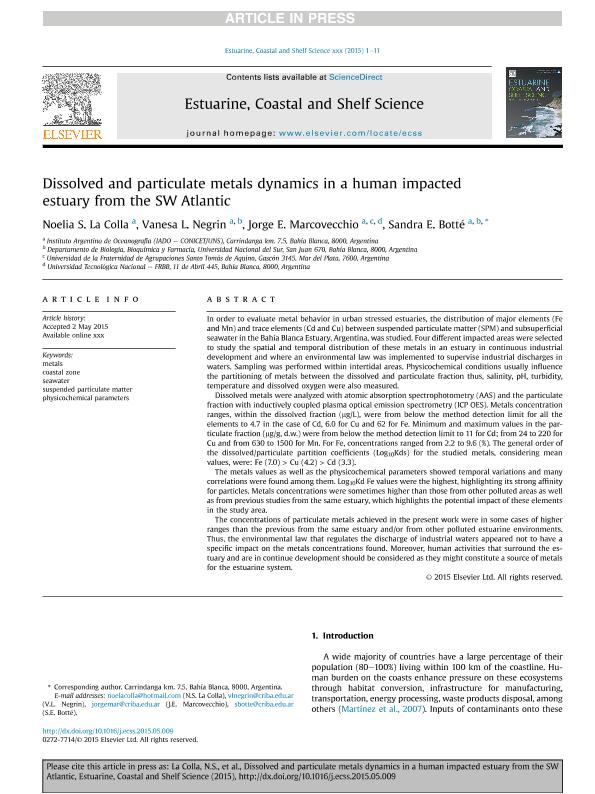Mostrar el registro sencillo del ítem
dc.contributor.author
la Colla, Noelia Soledad

dc.contributor.author
Negrin, Vanesa Lorena

dc.contributor.author
Marcovecchio, Jorge Eduardo

dc.contributor.author
Botté, Sandra Elizabeth

dc.date.available
2017-02-03T20:26:18Z
dc.date.issued
2015-12
dc.identifier.citation
la Colla, Noelia Soledad; Negrin, Vanesa Lorena; Marcovecchio, Jorge Eduardo; Botté, Sandra Elizabeth; Dissolved and particulate metals dynamics in a human impacted estuary from the SW Atlantic; Elsevier; Estuarine, Coastal and Shelf Science; 166; Part A; 12-2015; 45-55
dc.identifier.issn
0272-7714
dc.identifier.uri
http://hdl.handle.net/11336/12496
dc.description.abstract
In order to evaluate metal behavior in urban stressed estuaries, the distribution of major elements (Feand Mn) and trace elements (Cd and Cu) between suspended particulate matter (SPM) and subsuperficialseawater in the Bahía Blanca Estuary, Argentina, was studied. Four different impacted areas were selectedto study the spatial and temporal distribution of these metals in an estuary in continuous industrialdevelopment and where an environmental law was implemented to supervise industrial discharges inwaters. Sampling was performed within intertidal areas. Physicochemical conditions usually influencethe partitioning of metals between the dissolved and particulate fraction thus, salinity, pH, turbidity,temperature and dissolved oxygen were also measured.Dissolved metals were analyzed with atomic absorption spectrophotometry (AAS) and the particulatefraction with inductively coupled plasma optical emission spectrometry (ICP OES). Metals concentrationranges, within the dissolved fraction (mg/L), were from below the method detection limit for all theelements to 4.7 in the case of Cd, 6.0 for Cu and 62 for Fe. Minimum and maximum values in the particulatefraction (mg/g, d.w.) were from below the method detection limit to 11 for Cd; from 24 to 220 forCu and from 630 to 1500 for Mn. For Fe, concentrations ranged from 2.2 to 9.6 (%). The general order ofthe dissolved/particulate partition coefficients (Log10Kds) for the studied metals, considering meanvalues, were: Fe (7.0) > Cu (4.2) > Cd (3.3).The metals values as well as the physicochemical parameters showed temporal variations and manycorrelations were found among them. Log10Kd Fe values were the highest, highlighting its strong affinityfor particles. Metals concentrations were sometimes higher than those from other polluted areas as wellas from previous studies from the same estuary, which highlights the potential impact of these elementsin the study area.The concentrations of particulate metals achieved in the present work were in some cases of higherranges than the previous from the same estuary and/or from other polluted estuarine environments.Thus, the environmental law that regulates the discharge of industrial waters appeared not to have aspecific impact on the metals concentrations found. Moreover, human activities that surround the estuaryand are in continue development should be considered as they might constitute a source of metalsfor the estuarine system.
dc.format
application/pdf
dc.language.iso
eng
dc.publisher
Elsevier

dc.rights
info:eu-repo/semantics/openAccess
dc.rights.uri
https://creativecommons.org/licenses/by-nc-nd/2.5/ar/
dc.subject
Metals
dc.subject
Coastal Zone
dc.subject
Seawater
dc.subject
Suspended Particulate Matter
dc.subject
Physicochemical Parameters
dc.subject.classification
Oceanografía, Hidrología, Recursos Hídricos

dc.subject.classification
Ciencias de la Tierra y relacionadas con el Medio Ambiente

dc.subject.classification
CIENCIAS NATURALES Y EXACTAS

dc.title
Dissolved and particulate metals dynamics in a human impacted estuary from the SW Atlantic
dc.type
info:eu-repo/semantics/article
dc.type
info:ar-repo/semantics/artículo
dc.type
info:eu-repo/semantics/publishedVersion
dc.date.updated
2017-02-03T17:53:51Z
dc.journal.volume
166
dc.journal.number
Part A
dc.journal.pagination
45-55
dc.journal.pais
Países Bajos

dc.journal.ciudad
Ámsterdam
dc.description.fil
Fil: la Colla, Noelia Soledad. Consejo Nacional de Investigaciones Científicas y Técnicas. Centro Científico Tecnológico Bahía Blanca. Instituto Argentino de Oceanografía (i); Argentina. Universidad Nacional del Sur; Argentina
dc.description.fil
Fil: Negrin, Vanesa Lorena. Consejo Nacional de Investigaciones Científicas y Técnicas. Centro Científico Tecnológico Bahía Blanca. Instituto Argentino de Oceanografía (i); Argentina. Universidad Nacional del Sur. Departamento de Biología, Bioquímica y Farmacia; Argentina
dc.description.fil
Fil: Marcovecchio, Jorge Eduardo. Consejo Nacional de Investigaciones Científicas y Técnicas. Centro Científico Tecnológico Bahía Blanca. Instituto Argentino de Oceanografía (i); Argentina. Universidad FASTA "Santo Tomas de Aquino"; Argentina. Universidad Tecnológica Nacional. Facultad Regional Bahía Blanca; Argentina
dc.description.fil
Fil: Botté, Sandra Elizabeth. Consejo Nacional de Investigaciones Científicas y Técnicas. Centro Científico Tecnológico Bahía Blanca. Instituto Argentino de Oceanografía (i); Argentina. Universidad Nacional del Sur. Departamento de Biología, Bioquímica y Farmacia; Argentina
dc.journal.title
Estuarine, Coastal and Shelf Science

dc.relation.alternativeid
info:eu-repo/semantics/altIdentifier/url/http://www.sciencedirect.com/science/article/pii/S0272771415001584
dc.relation.alternativeid
info:eu-repo/semantics/altIdentifier/doi/http://dx.doi.org/10.1016/j.ecss.2015.05.009
Archivos asociados
